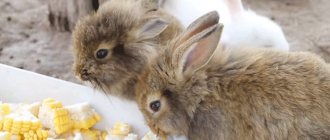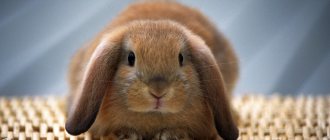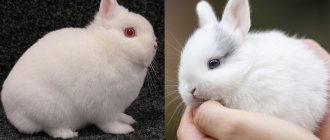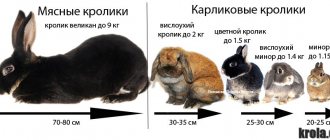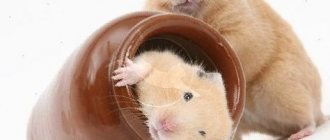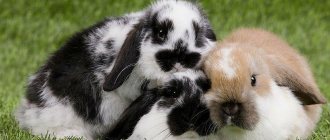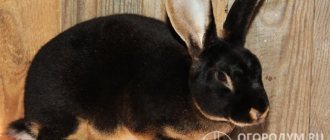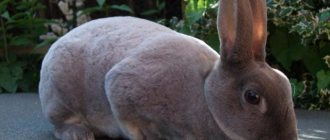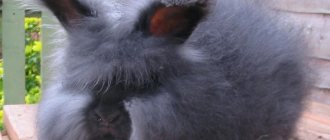What's the best way to keep rabbits?
Rabbits, for all their fertility and profitability, require increased comfort of keeping. They cannot tolerate extreme heat and may die in freezing temperatures in winter. Caring for them should provide clean rooms, fresh air, clear water and adequate feeding. ... Free content
- in enclosures;
- in pits;
- on pasture.
Interesting materials:
How many heroes are there in League of Legends? How many chapters are there in Mkx? How many races are there in Forza Horizon 4? How many states are there in the European Union? How many states were part of the CIS? How long does it take to prepare a passport? How many degrees of frost can apples withstand? How many grams of protein are in 200 grams of cottage cheese? How many grams of protein are in a chicken thigh? How many grams of protein are in Whey Protein?
What determines the growth rate?
The rate at which rabbits grow depends largely on their breed.
In addition, the growth rate is influenced by nutrition, which at first consists of mother's milk, containing all the nutrients and vitamins. Thanks to this, immunity is developed that protects the animals for the entire life allotted until slaughter.
The female's lactation depends on the following factors:
- conditions of its detention;
- the breed to which it belongs;
- age;
- number of births before;
- the time of year when the birth occurred;
- number of newborns;
- the time during which feeding occurs.
There are many high-milk breeds. Among rabbits raised for meat, the championship belongs to the Californian breed, and the New Zealand White takes last place. The most favorable period for high lactation is the summer period, when the female is provided with adequate nutrition.
Ready-made feed
In finished feed, the crude protein content can vary between 16 and 18%. This corresponds to about 12-13% of digestible protein. The crude fiber content is about 16%. It decreases if the feed contains more energy. Crude fiber in feed is extremely important because it ensures proper digestion of food.
But the high fiber content makes the feed more expensive. Crude fiber is introduced into feed mainly in the form of wheat bran and artificially dried and then crushed alfalfa, which is known as grass or alfalfa meal. The production of this alfalfa requires a lot of energy and is therefore expensive.
Nutritional recommendations for feed for rabbits (DLG 1995 and Martens 1998)
Requirements for finished feed for rabbits (DLG standard)
Vitamins, microelements and minerals are also necessarily included in the finished feed. Flavophospholipol or flavomycin can be used as growth stimulants. These are antibiotics that, at low concentrations, support healthy microflora of the digestive tract and thereby improve the digestibility of feed. Various coccidiostatic agents can be used to prevent coccidiosis.
Did you find this article useful? Forward the link to your colleagues!
I look forward to your feedback and comments. Thank you very much!
Main types of jigging
It is recommended to separate baby rabbits from the female rabbit in the following ways:
- Simultaneous jigging. This method is applicable for compacted births for month-old offspring. The entire brood is simultaneously transplanted into prepared cages and given good fortified food with mineral supplements. Sometimes, in order to reduce the fright of the babies, they are left in the parents’ house, and the female is transferred to another rabbitry.
- Weaning with periodic refilling. This method is rarely used in practice. But usually the offspring are moved from a new home to the mother’s cage and back if it is not possible to provide the eared animals with adequate nutrition or they are developing slowly.
- Sorting by degree of development. If the female has a lot of milk, then the cubs are removed according to the degree of development. First, the strongest individuals are selected, after a couple of days, the rest are grown. This method is not used for compacted births.
Nutritional supplements for artificial weight gain
To improve appetite, breeders add vitamins to pet food. Beneficial substances of groups A and E are used together with fats, vitamin D is added to thick and porridge-like food. The drink is diluted with vitamin C.
After consultation with a veterinarian, animals are prescribed vitamin-mineral, as well as protein-vitamin-mineral supplements (PVMD).
They strengthen the animals’ bodies with useful microelements: manganese, calcium, phosphorus. Protein-containing options provide protein to the animal's muscles.
Vitamin and protein supplements have no contraindications. The correct dosage is calculated taking into account the body weight and age of the pet. The use of additives above the norm worsens the taste characteristics of rabbit meat.
Compound feed
In rabbit farming, we should not forget about feeding rabbits with compound feed. The task of any compound feed is to comprehensively fill the rabbit’s body with various nutrients and vitamins. And their differences lie not so much in the composition (it is approximately the same), but in the purpose, which is dictated by the ratio of the elements. The feed includes all of the above products in granular mixed form.
Pelleted food for rabbits
The most commonly used are complete feeds. This is, so to speak, a main dish that has a little bit of everything. The main emphasis here is on grains and protein products, with a small admixture of mineral supplements.
Now to the question of how much feed a rabbit eats per day. Typically, complete feed is given daily to all adults in the amount of 110-120 g, and to young animals - 2 times less.
Concentrated feeds are characterized by an increased presence of any components. Usually these are seeds, cakes or mineral supplements. It is usually given during mating or lactation, when animals especially need to compensate for the lack of certain substances. In supplementary feeds, most often, the percentage of the main components is reduced due to specific vitamin supplements.
Water in the diet
Fresh fresh water should be provided daily and a constant supply of clean drinking water should be available to hydrate the digestive tract. Without sufficient water level, the contents may become dry and stuck. This leads to life-threatening intestinal stagnation. Medical assistance must be provided urgently. Restriction in drinking water leads to pathological changes in the blood, impaired thermoregulation, and nephritis.
When a female rabbit is thirsty during birth, she often eats her offspring. The daily drinking requirement of a pregnant female is up to a liter, and that of a lactating female is up to 2.4. Young animals aged 9 weeks require up to 2.5 liters of water.
Water has a positive effect on digestion and prevents intestinal stagnation
A heavy ceramic bowl is the most preferable option for drinking.
Water containers should be thoroughly washed with soap every two days.
In household plots, it is advisable to install automatic watering.
Interesting facts about Eared Ears
- They grow very quickly.
- The queen has a litter of 2 to 8 babies.
- Grown in a small space.
- Production costs are lower than for other large animals.
- The meat is tasty, nutritious and easily digestible. Even older people eat it without problems.
- Eating rabbit meat is not prohibited by any religion.
- Kitchen waste, grass, plant leaves are the favorite food for long-eared animals. You can breed for the needs of your family.
- Such farming requires less labor compared to other livestock farming businesses.
- Commercial farming can be a successful family business and does not require a large capital investment.
- You will probably get your investment back in a short time.
- This profitable business will be an excellent source of income and employment.
- By raising several individuals, it is possible to satisfy the needs of one family.
A proper diet is the key to health!
I will repeat a common truth, which, however, most rabbit breeders lose sight of: rabbit food must be perfectly balanced. As experienced rabbit breeders say: If you feed only hay, the rabbit will only grow ears. Translating into a more scientific language, I will say that the speed of weight gain and the condition of the gastrointestinal tract of animals depend on the quality and calorie content of food.
Feeding only hay is an extremely low-calorie diet that will support life and healthy intestinal motility. To gain weight, animals need to be fed grain bait, whole grain or crushed grain. In addition, they are given mineral supplements and soft food. Instead of creating a menu manually, it is easier to purchase ready-made feed - a balanced mixture of grains, bone meal and minerals.
A varied diet is the key to the health and rapid growth of a rabbit.
Minerals are especially needed by breeding animals and those breeds that are raised for fur. Grain mixtures containing legumes, corn, sunflower or rapeseed are available for sale. These supplements are high in calories and promote weight gain.
There are foods that are contraindicated for animals:
- fresh grass on which pathogenic bacteria are present, because in 95% of cases, epidemics that can destroy livestock in the territory of an entire village are transmitted precisely through fresh leaves;
- some types of plants containing toxins: foxglove, lily of the valley, henbane, colchicum, lumbago, buttercup and others;
- branches of stone fruit trees and the essential oils they contain are toxic to animals;
- bread crumbs can clog the intestines, which leads to the painful death of animals within 24 hours.
Herd reproduction
- Rabbit mating
- Okrol
- Growth and development of rabbits
- Jigging and rearing of young animals
The high intensity of reproduction in rabbits is due to multiple births, a short period of gestation, early physiological maturity and the ability to combine gestation with lactation. They can be fertilized and give birth throughout the year, and only in the fall does sexual activity decrease somewhat.
Puberty in rabbits occurs on the 90–110th day of life. However, they cannot happen at this age, since the development of the body has not yet ended. Rabbits of medium-sized breeds (New Zealand White, California White, Californian, Vienna Blue) can be bred for the first time at the age of over four to five months, after they have reached approximately 80% of the weight of full-aged animals. Males should be bred for the first time at 5–6 months of age. Females of large and medium breeds are recommended to be aged over five months at a weight of 3.5 kg and 3.2 kg for small breeds.
The ratio of males to female rabbits during manual mating should be on average 1:8 (sometimes up to 12 females per male). The period of use of breeding females in a herd is three years, sometimes four to five years.
For the expanded reproduction of the herd, it is important to accurately determine the timing of mating, timely preparation of rabbits for it, proper feeding and maintenance of breeding animals at this time.
The premises and equipment are repaired and disinfected before the start of mating. Males and females must have factory fatness and receive food rich in vitamins and proteins.
A veterinary examination of all livestock is carried out 15 days before mating. The purpose of such an inspection is to identify and remove sick animals from the herd. Sick people and those suspected of having the disease are culled and sold for meat, animals below average fatness are transferred to enhanced feeding, and those who are obese are reduced in diet and given more hay or green grass. Obese female rabbits do not cover well, give birth to weak and dead rabbits, and obese males do not mate well and produce sperm of poor quality.
Females are prepared for mating after the rabbits are weaned, that is, 30–45 days after the previous birth. In order to get friendly round litters, mating must be carried out within 4–6 days. In summer, females are covered in the morning and evening, in winter - during the daytime, when the air temperature in the rabbitry is higher.
On the first and second days after giving birth, the female rabbit is in a state of strong sexual heat. For female rabbits, it lasts several days; the next hunt occurs after about 8–9 days. Hunting in females can be determined by her behavior and the appearance of her genitals. Females that have come into heat show noticeable restlessness, move around the cage a lot, sometimes refuse food, and begin to pluck fluff to build a nest. When stroking the female's back, she lies down on the floor of the cage and stretches out.
At rest, the genital loop is pale in color and not enlarged; in heat it is swollen and has a bright pink color.
When a male approaches, the female in heat takes a characteristic pose - she raises her hindquarters.
Mating of female rabbits should be carried out under supervision, preferably in a male's cage. The female is considered covered if the male falls to the side after mounting, emitting a characteristic squeak.
The female is usually assigned to one male. After covering, the female rabbit is immediately transferred to her cage, so as not to exhaust the male with repeated cages. On the 5th–6th day, mating is repeated. The female's refusal to mate is considered a sign of pregnancy. On the 13th–15th day after mating, it is necessary to determine the female’s pregnancy by carefully palpating the belly in the pelvic area. In a pregnant female, the uterus is greatly enlarged; the embryos, each the size of a cherry, can be easily felt in it in the form of two parallel soft chains. It is not recommended to probe later; it can cause an abortion.
The gestation period lasts about 28 to 32 days. But sometimes in rabbits o. Its essence is as follows: after ovulation of mature eggs and mating, the remaining follicles in the ovary turn into corpus luteum and secrete the hormone progesterone to develop the pregnancy process. If the egg is not fertilized, the corpus luteum, remaining in the ovary for 15–16 days, continues to secrete the hormone and create a state of pregnancy. At the end of this period, the female rabbit begins to prepare the nest, plucking fluff from herself, but after 1–2 days her maternal instinct gradually disappears.
A female can be conceived the next day after giving birth, but the fertility rate is no more than 50%. When covered 10 days after birth, the fertility rate reaches 80%. Early covering of lactating queens increases the death of embryos in their subsequent development.
Sometimes rabbits experience double pregnancy. This phenomenon is called "superfetation". The rabbit, being pregnant, allows herself to be covered. The anatomical structure of her reproductive apparatus is such that in each horn of the uterus there can be embryos of different ages, which, accordingly, after the end of their development, will be born at different times. This greatly exhausts the female rabbits and contributes to the birth of weak rabbits.
On industrial farms, artificial insemination has proven itself best. The ejaculate of one rabbit obtained in one cage is enough to fertilize 50–100 females. Artificial insemination makes it possible to most successfully use valuable sires, effectively combat sexually transmitted infections, and reduce the costs of maintaining a large number of males. But it has not found widespread use due to a number of biological and technological reasons.
In the wild, birth occurs in burrows in an intimate environment. Such habits have also been preserved in domestic rabbits. To do this, 5–6 days before giving birth, the females place a portable nesting box in the cage, filling it 2/3 with dry and soft bedding. 3-4 days before giving birth, the female rabbit makes a nest, crushes the bedding with her teeth, and plucks out the fluff in the chest and abdomen. During this period, you need to be on duty in the rabbitry, especially carefully monitoring the birth of young females, who can scatter the rabbits or crush them. During this period, the temperature in the rabbitry should be maintained within 18–20 °C, and care must be taken to ensure that the baby rabbits do not crawl out of the nest, since outside the nest, even at a temperature of 15–20 °C, they freeze and die.
A normal birth lasts 10–40 minutes. More often it occurs at night. After giving birth, the female eats the placenta, feeds the young rabbits and places them in the nest. After the birth, it is necessary to inspect and carefully insulate the nest, count the baby rabbits and remove stillborn ones, if any. Warm the frozen rabbits and place them in a box with down for 2–3 hours.
In the queen cell, the female selects a darkened part and makes a nest there.
Often females, especially young ones, crawl on the floor of the cage. After the mother rabbit licks and feeds the babies, they need to be transferred to the nest.
Sometimes individual females eat their rabbits after giving birth. This may be due to severe thirst, inadequate feeding, difficult childbirth, mastitis or cracked nipples, strong sexual arousal, the presence of a dead rabbit in the nest, etc. If, after eliminating the causes, this phenomenon repeats, the female is discarded and score. The mother rabbit usually feeds the young rabbits once a day at the same time. 7–9 well-developed rabbits are left under adult females, and 5–6 under young ones. The extra ones are placed with a young female if the births coincide or the difference is 1–3 days. But you should know that the smell of other people's rabbits causes anxiety in the female rabbit, and she can bite them to death. To prevent this from happening, the baby rabbits are cleaned of fluff and remnants of bedding from the previous nest and placed in the middle of the new nest, after removing the nurse from the cage for 20–30 minutes.
In farms where the number of baby rabbits is limited and there is no one to place the baby rabbits, the baby rabbits can be fed artificially. For this purpose, it is necessary to make a special pacifier, which consists of a bottle with a stopper. Burn a hole in the cork through which to pass a tube or rod of a chicken feather, and put a rubber band on the rod. 3/4 cow's milk and 1/4 condensed milk are poured into the bottle. The tip of the nipple rubber is inserted into the baby rabbit's mouth. One feeding requires 4–5 grams of milk, and baby rabbits need to be fed 4–6 times a day.
From the 20th day, baby rabbits can be fed from a regular nipple until they are one month old, and at one month of age they lap up milk from a saucer and gradually become accustomed to ground grain and mixed feed added to the milk.
Rabbits are born naked and blind, weighing 40–80 g with 16 milk teeth. On the sixth day after birth, the live weight of a baby rabbit doubles during normal development, on the 20th day it increases 5–6 times, and by one month it increases 10 times and reaches 250–300 g (see Table 3).
By the end of the first day, the appearance of primary hair is noticeable on the baby rabbit’s head. On the 5th–7th day, the rabbits are covered with guard hairs and the rudiments of guide hairs appear. By 20–25 days of age, the primary hairline reaches full development. Rabbits open their eyes at the age of 10–14 days. On the 15th–20th day, the females’ milk production noticeably decreases, the baby rabbits crawl out of the nest and begin to learn to eat food. During this period, the female needs to increase her daily diet at the rate of 12–15 g of feed units and 2–3 g of digestible protein per rabbit. Already at 30 days of age, rabbits eat food well. When the rabbits reach 20–25 days of age, the queen cells are removed from the cages.
Table 3.
Age-related changes in live weight (g) of rabbits of various breeds (compiled by: Avakyan Z.L., Gnoiko V.A., Miros V.V., Pomytko V.N., etc.)
Successful rearing of suckling rabbits is largely determined by the milk production of females. Over 27–28 days of lactation, the female secretes from 3 to 3.7 kg of milk, of which 2.5–2.9 kg in the first 20 days.
In the first two to three days after birth, rabbits feed on colostrum, which contains many nutrients, minerals, and vitamins. It has a protective effect against various diseases. Rabbit milk is very thick and nutritious: it contains on average 15–27% fat, 10–15% protein, 2% milk sugar, 2–2.5% minerals (mainly calcium and phosphorus). In winter, the fat content of mother rabbits' milk increases. The high nutritional value of mother's milk contributes to the rapid growth of rabbits.
For 1 g of growth, the baby rabbit uses up to 2 g of mother's milk.
Young animals are separated from the female rabbit at different periods, depending on the rearing technology. With compacted litters on the 28–29th day, with semi-compacted litters on the 35–45th day, with broiler rearing - at 60 days of age and immediately sold for meat, and according to I. Mikhailov’s technology, after 90 days the healthiest livestock is raised.
The removed young animals are placed in cages of 3–5 heads and 10–15 in an enclosure, separately by sex, age and development, based on 0.09–0.1 m2 of cage or enclosure area.
To determine the sex of a baby rabbit, take it with your left hand by the skin in the area of the sacrum, grabbing the tail, turn it over with its belly up and with the fingers of the right hand push the skin on the abdomen forward. In females, an oblong slit is visible, directed towards the tail; in males, a tube-shaped penis is found.
From the age of three months, replacement males are placed one at a time, and females two or three in a cage.
Table of contents
Composition of complete feed
Up to 45% of the combined feed consists of ground grain crops. Ready-made mixtures are made from oats, corn, wheat, and barley. A large percentage of the grain group is found in feed for young animals and females during lactation. There are 4 groups of rabbit feed composition:
- Weaning. The product contains substances that help strengthen the growing body of rabbits. The overall calorie content of weaning feed is low.
- Fattening The mixtures are characterized by increased calorie content and high protein concentration. When feeding a rabbit with food of this category, you should strictly adhere to the standards specified by the manufacturer. Failure to follow the manufacturer's recommendations will result in the fat layer starting to increase instead of meat.
- Lactation. This rabbit feed contains more vitamins and microelements. Females use it not only while feeding their young rabbits, but also during the first month after weaning the offspring.
- Medicinal. While raising animals, many farmers face various veterinary problems. Medicinal feeds contain vitamins, microelements, antibiotics and other drugs designed to combat the most common diseases. also produces health-improving mixtures according to individual requests.
The compositions of feed for industrial and shed breeding will also differ. In the second case, animals will need less fiber and more protein. Rations will be seasonal. Traditionally, the energy indicators of winter mixtures will be higher than summer ones. For rapid growth and gain of muscle mass, the following is added to the feed:
- soybean meal;
- wheat bran;
- vitamin-herbal
flour;
- sunflower and soybean cake;
- meat or fish meal (no more than 5% of the total composition).
Except
vitamin and mineral
complex, chalk, table salt, and premixes are added to the mixture.
Methods of raising rabbits for meat
Animal nutrition is the basis of rabbit breeding.
Two methods are used for fattening rabbits:
- broiler;
- ordinary.
In large and medium-sized farms containing 200 animals or more, both technologies are being introduced simultaneously. In homesteads, the usual method of feeding is used.
Broiler method of breeding rabbits
The peculiarity of the method is the short period of feeding the young animals and the savings on cages. One fattening cycle takes 90 days.
Feeding rabbits at home is not complete without hay and branches of various trees.
During feeding, the rabbits remain with their mother. After finishing fattening, the female is transferred to the male for mating. In a year, a female rabbit gives birth to up to 24 babies.
This is interesting! The skin of broiler rabbits is inexpensive, but the meat is in great demand due to its nutritional value and taste.
Advantages of the broiler method:
- there is no need to equip group cells;
- concentration of livestock in one place allows for quick care of rodents;
- with constant feeding on mother's milk, the baby rabbits reach a weight of 3-4 kg by the third month;
- raising two hundred females at the same time produces about 8 centners of pure meat per year.
The intensive breeding method depletes the immune system of females and reduces milk production. Lack of sanitary standards during feeding leads to disease of the mammary glands in the rabbit.
The percentage of concentrated impurities for a nursing female is 45-50% in summer and 65% in winter. For the growth of young animals, 155 g of protein is added at each feeding. Water is included in the diet in unlimited quantities.
Common method of fattening young rabbits
When learning how to properly feed rabbits, pay special attention to dangerous foods that should be avoided.
The use of conventional fattening involves the removal of young animals from their mother after two months. While the cubs are on suction feeding, the female rabbit is provided with intensive 5 meals a day.
The basis of nutrition for rabbits is concentrates. In the first week, at least 500 g of food is consumed per pet, of which 450 g is a legume-cereal mixture, 50 g is grain.
By the third and fourth months, the volume of feed increases by one and a half, two times. At slaughter, the daily norm (800-950 g) remains the same.
This is interesting! Conventionally fed rabbit meat does not have high nutritional value. The sale of fluffy animal skins brings great profit to breeders.
At five months or six months of age, the animal is sent to slaughter. By this time, body weight reaches 4-5 kg.
Preparation for slaughter
It is advisable to have rabbits examined by a veterinarian in order to cull sick animals. Isolation should be carried out - individuals selected for execution should be placed in a separate small cage for a day.
In order for the animal to cleanse its intestines, you should stop giving it food no less than 10-12 hours from the expected time of slaughter. You can extend this period by a day. They continue to give water not to quench thirst, but to remove feces from the body.
Before slaughter, you need to wash the rabbit and let it dry. Rabbits are shy animals, so you need to choose a quiet, calm place for slaughter. There should be no strangers or other pets there.
You should prepare all the necessary tools in advance and protect the surface from traces of blood with film. The worker must wear an apron and gloves.
What to feed for rapid growth and weight gain
In households, rabbits are raised mainly for meat. To fatten rabbits for meat at home, you can use various schemes, but protein and carbohydrate products are required. Grass and fresh vegetables still remain the basis of the diet, but it should also include grains of various crops, whole or crushed, cake and bran. For rapid growth, rabbits need to be fed legumes - green plant matter and ripe grains.
When the young animals grow up, in order to quickly gain weight, you need to feed the rabbits the food in which carbohydrates and fats predominate, that is, potatoes, grains, add animal feed - fish and meat and bone meal, concentrated milk powder, fish oil.
Daily norm
How much feed a rabbit eats directly depends on its breed, weight, age, and physiological state. Animals are rarely fed exclusively combined feed; farmers often practice mixed feeding. The consumption of ready-made mixtures will be less. Professional veterinarians recommend introducing premixes into the diet when mixed feeding. They will help strengthen the immunity of animals and prevent the development of vitamin deficiency. With mixed feeding:
- In summer, the amount of green food will be 450–550 grams per day, and the concentrated mixture will be 60 grams.
- In winter, animals are given 200–250 grams of fresh food, 110–160 grams of hay and 60–70 grams of mixture.
- Pregnant rabbits are given 600–750 grams of fresh food and 80–90 grams of concentrated mixture.
- During lactation, the amount of green food increases to 1.5 kg per day, and mixtures - to 160 g. Hay is also added to the diet (250-300 g).
When feeding ready-made mixtures, the feed rates for the rabbit will be different:
- Adults - 110–120 g.
- Young animals - 50–60 g.
- Pregnant females - 140–150 g.
- Lactation period - 300–350 g.
The amount of food for females is determined by the number of rabbits.
As birth approaches, the amount of combined feed should be increased. The average daily feeding rate for rabbits is 90 grams. This is exactly the amount of ready-made dry mixture that should be given to an adult animal daily. Little rabbits who are still fed from their mother should not be limited in the consumption of dry mixtures. The diet of young animals during the period from 1 to 3 months should be the same as that of rabbits during lactation. At 4 months, animals are transferred to special feed for weaning or fattening.
Some breeders give their animals pork feed instead of rabbit feed. It is not advisable to do this. Despite the fact that animals quickly gain weight on pig formulas,
because of
Excess protein overloads the liver and kidneys. As a result, the life expectancy and activity of producers is sharply reduced.
Where to begin
According to the existing classification, rabbits belong to the hare family of the order Lagomorpha. The family unites hares and rabbits. These animals are susceptible to stress and various diseases, but are quite unpretentious and are able to quickly adapt to various living conditions.
For those who have decided to start rabbit farming, it will be useful to learn about the main rules for keeping domestic livestock from the following video:
Breed selection
First you need to decide on the purpose of breeding. In rabbit breeding, there are four main areas for which specialized breeds have been bred:
- Meat. Such broiler-type animals, which quickly gain a live weight of about 4-4.5 kg in 4-6 months, are bred to generate income from the sale of dietary meat. The most popular and cost-effective varieties are New Zealand White and Californian.
- Downy ones. Animals of these breeds do not reach large sizes, therefore, despite the high taste and dietary characteristics of the meat, their fur is of greatest interest to breeders. This direction includes White downy and Angora rabbits.
- Meat skins. The most common universal breeds, allowing you to get both a meaty carcass and high-quality skin. Prominent representatives are the Soviet chinchilla, Rex, Vienna blue, Strokach, White giant and many others.
- Decorative. Breeding of small animals is not carried out for the purpose of slaughter and profit, but solely for the soul.
Rabbits of meat-and-skin breeds are the most versatile and in demand in commercial farming.
Definition of a healthy individual
Animals for further breeding should be purchased from breeders on large farms or farms with extensive experience and a good reputation.
When choosing, it is important to make sure that the animals correspond to the description of the breed and are completely healthy. The animal must be active, curious, and have a good appetite. A healthy individual is distinguished by:
A healthy individual is distinguished by:
- sparkling eyes;
- dry or slightly damp nose;
- shiny and even coat, including around the anus;
- clean, pink inside ears;
- soft belly;
- straight (not sagging) back.
A careful visual inspection of the rabbit before purchasing will help you choose a healthy individual suitable for breeding and further reproduction
Sizes: furry giants and babies
During selection, two hundred breeds of animals were bred, and they all differ not only in characteristic habits, color and length of fur, but above all in weight and size.
Breeding standards
The range of values is so wide that all domestic rodents are classified into four main groups:
- Dwarf breeds grow up to 20 cm. Dwarf. For the smallest, dwarf breeds, the standard weight is from 1 kilogram to one and a half. Animals weighing 1.3 kg and measuring no more than 20 cm have an ideal proportion.
- Small ones. The main distinguishing feature of a small ornamental animal from an ordinary meat rabbit is its relatively small weight. An adult rarely exceeds the limit of 2 kilograms with a body length of 25 to 30 cm.
- Average. Rabbits of this group, when growing up, quickly gain weight up to 4 kg, and the length of the body extends to 57 cm.
- Large ones. Real giants, striking the imagination with their accumulated mass. The record weight is 8 kg, and the size of the carcass reaches 70 cm.
Eared giants
Among some breeds, animals of truly outstanding size stand out:
- Eared giant. English fold. The breed is considered the oldest and remains the most popular in England. The weight of an adult giant rabbit reaches 5.5 kg.
- French Fold. At the end of the 19th century, a new breed was obtained by crossing the English and French rabbits, the representatives of which grow up to 6.8 kg.
- Dutch, the weight of the animal reaches 5 kg.
But the real giants are the rodents bred by Soviet breeders in the middle of the last century. Combining the desire to obtain animals with high vitality, precocity and excellent health, scientists crossed the English breed of large animals with local ones, which were distinguished by their large body weight. Thus, scientists obtained giant rabbits with good genetic characteristics:
- Breed Gray giant. Gray giant. The average weight of an adult animal is 4-6 kg, and record-breakers weigh more than 7 kg.
- Soviet chinchilla. The weight of an adult animal reaches 5 kg; for particularly large rabbits it is 7–8 kg.
The leading place in terms of size is occupied by the Belgian Flanders. A long rabbit, growing up to 70 cm, with thick, luxurious fur. Ordinary animals weigh from 7 kg, some grow up to 10-12 kg, and the recorded record is 25 kg.
Common Causes of Early Death
There are a number of recommendations that will help to significantly increase the life expectancy of decorative rabbits.
- do not give the animal food from the common table (sweets, meat, bread, crackers);
- in order to prevent the development of colds, do not let your pet walk in a draft or near heating devices;
- Babies need to be bathed extremely rarely; after bathing, the baby rabbit needs to dry thoroughly, so keep it in a dry towel until completely dry;
- do not allow the animal to be injured, so do not drop or step on the pet;
- to grind down the incisors, which grow throughout their lives, rabbits need to be given information from trees and shrubs;
- domestic rabbits have difficulty withstanding high temperatures, stuffiness, high humidity and dampness;
- hay, like other products, should not be rotten or wet;
- It is recommended to accustom animals to new products gradually;
- domestic eared cats need vitamins and minerals;
- The water in the sippy cup should be clean and at room temperature.
Any pet needs attention and affection. Then the question of how many years decorative rabbits live will disappear on its own. An active and playful animal lives to the maximum.
Among the candidates for a hearty and tasty meal:
- Adults who have reached slaughter age and weight, according to the characteristics of their breed and which you decide not to keep for procreation.
- Young rabbits that exhibit deviations in constitution (physique), growth retardation, and increased aggression in behavior.
- Healthy young animals if you decide to save on cages and reduce the time required to raise animals.
- All of the above are rabbits, but in which by the end of fattening the molting process will completely end. Taking into account the characteristics of these animals, the most likely time frame will be from October to January.
Table of average weight of different breeds by month
To quickly determine the weight of a rabbit, scheduled by month, without going into detail, many breeders use special tables. You can find them online in all sorts of variations, taking into account different breeds.
As an example, one such table is presented below:
Attention! This list shows only average values, suggesting certain deviations up or down. But these numbers give the breeder a guideline with which to refer in the process of raising animals.
